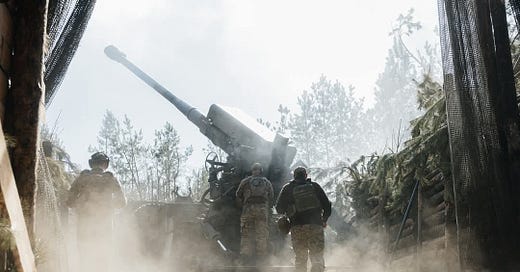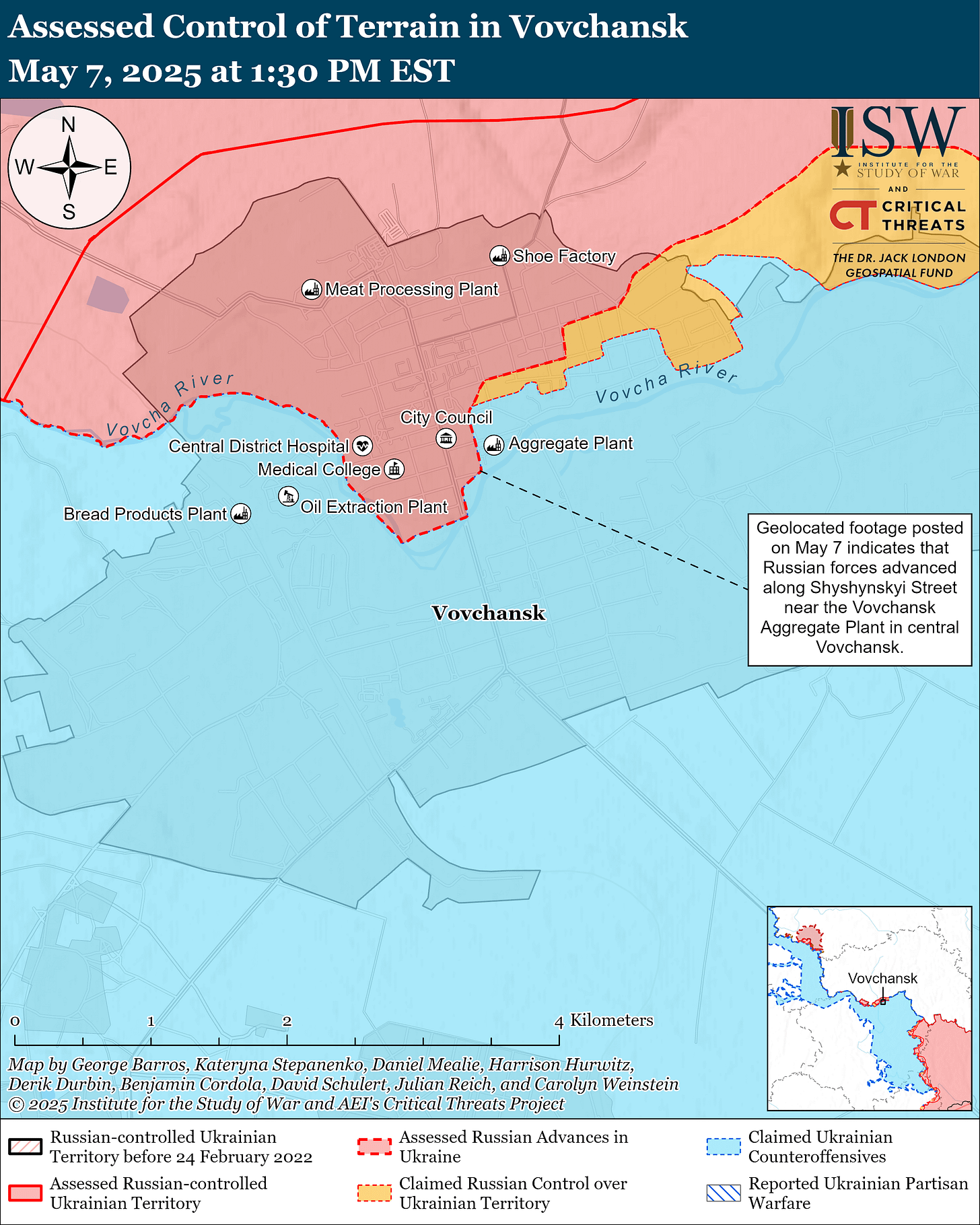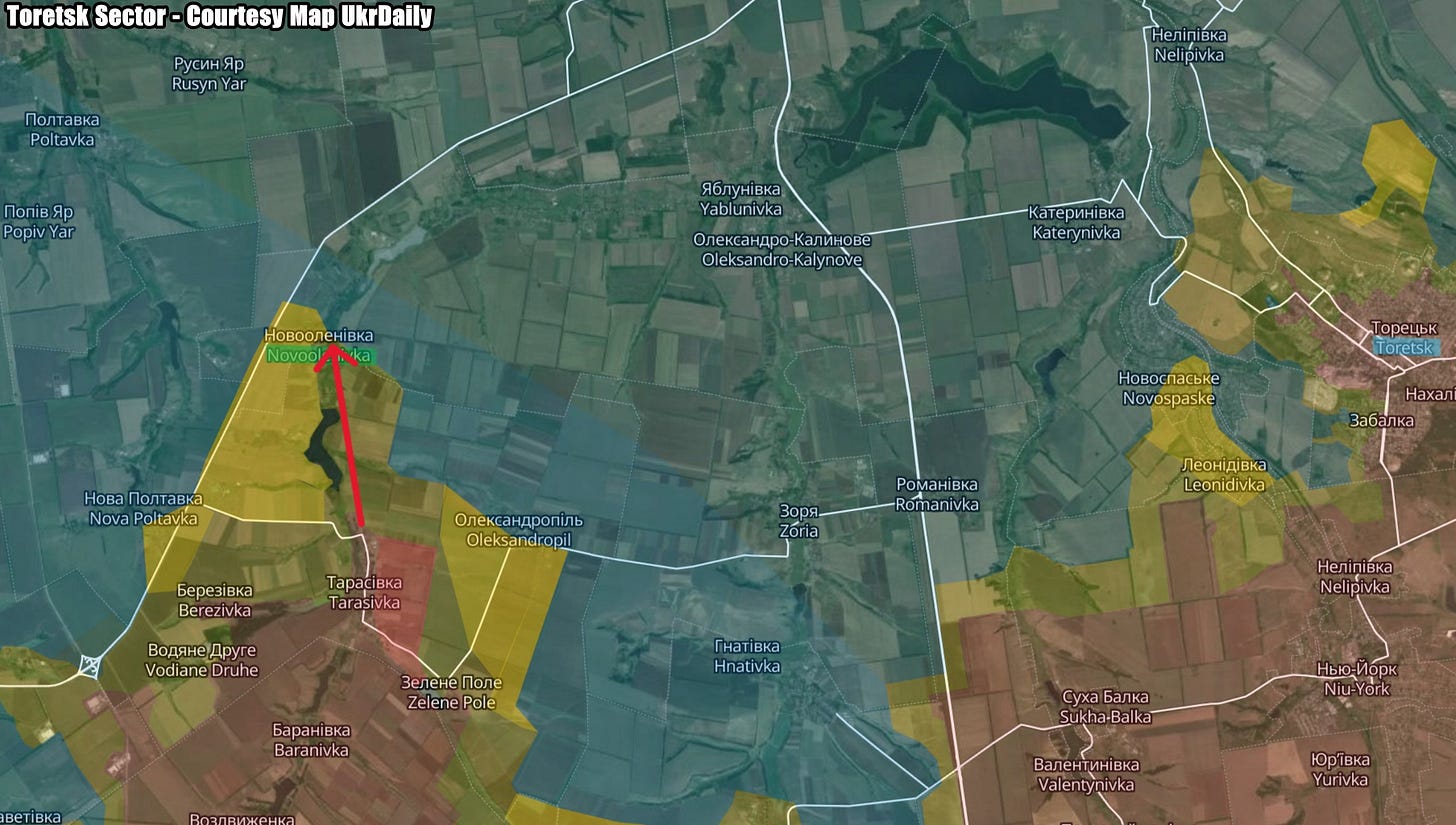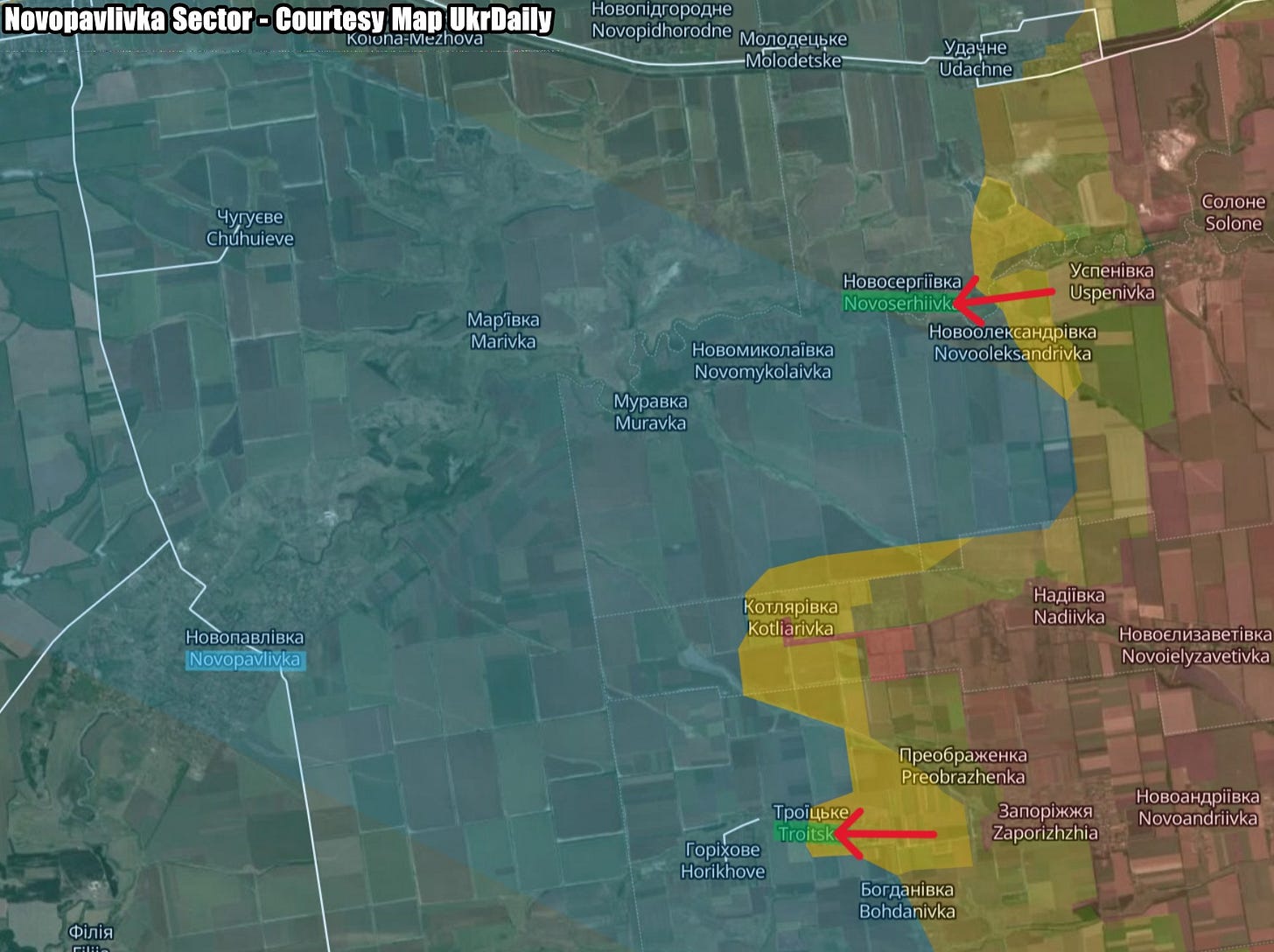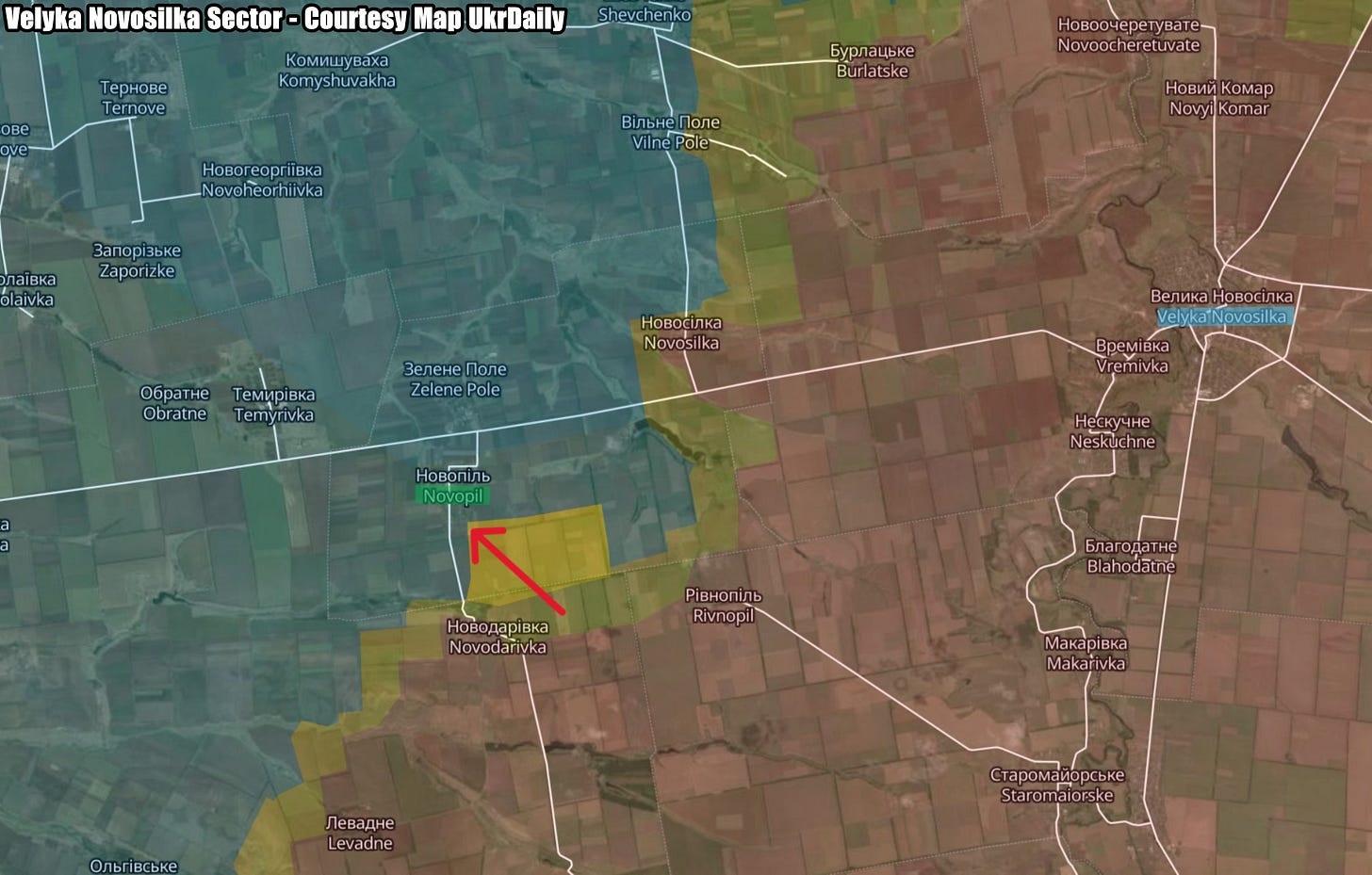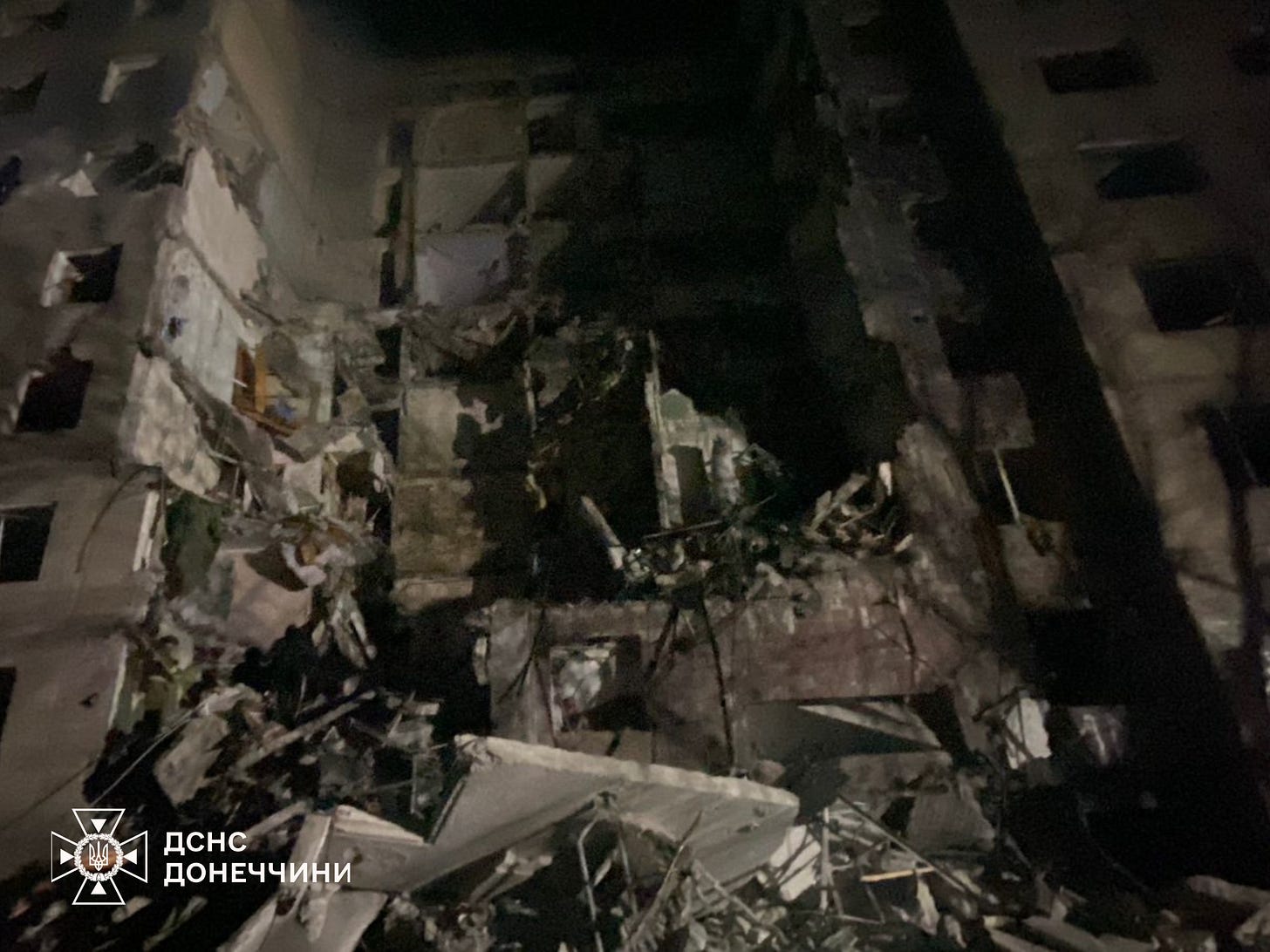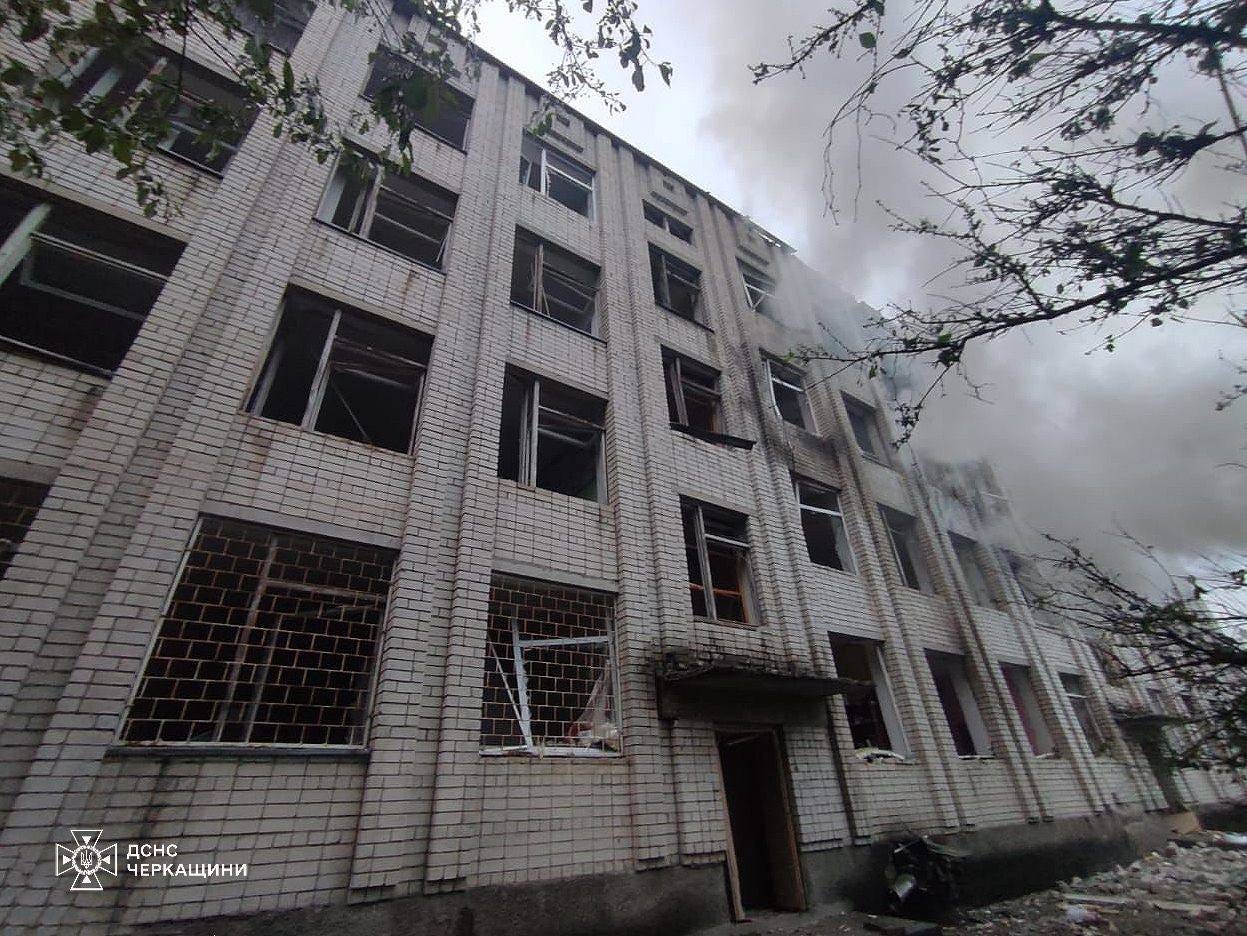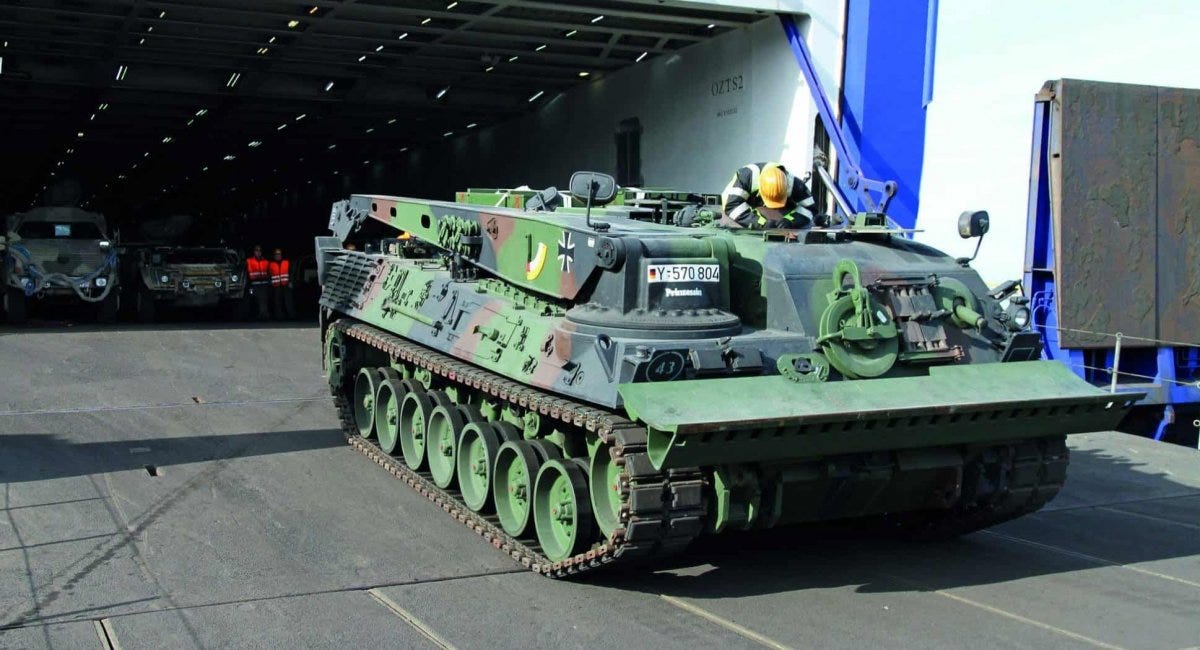Slava Ukraini! In early 2022 I began a Telegram channel aggregating news from a number of sources daily on the war in Ukraine. In June 2023 I began providing a daily draft for the Ukraine War Brief Podcast collecting news from over 70 sources daily, which formed the basis of the script. While the Podcast no longer exists I have continued to make this Brief available for my followers here on Substack for those who wish to keep up with the news from the war.
If you find the Brief informative I would appreciate it if you shared it with others.
All the latest news on the Russo-Ukraine War 6 days per week
ALONG THE CONTACT LINE
GSAFU Morning Report
For: May 8, 2025
The General Staff of the Armed Forces of Ukraine in its Operational Information update at 08:00 on May 8 stated that day 1170 of the full-scale invasion of the Russian Federation against Ukraine had begun.
The situation on the line of combat remains tense in some sectors. Ukrainian defenders continue to actively counteract the Russian aggressor, causing them significant losses in personnel, equipment and technology. Exhausting the enemy along the entire front line and continuing to disrupt the plans of Russian occupiers to advance deeper into the territory of Ukraine.
During the past day, 196 combat engagements took place.
Over the past 24 hours, the enemy carried out 2 missile strikes, 89 air strikes, used 2,891 attack drones and fired approximately 6,000 artillery shells across the positions of Ukrainian forces and civilians.
Air Force Daily Report
20 ENEMY UAVS SHOT DOWN, 6 SIMULATOR UAVS FAILED TO REACH THEIR TARGETS (LOCATIONALLY LOST)
➖➖➖➖➖➖➖➖➖
Between 2:30 p.m. and 8:30 p.m. on May 7 (during the third wave of attacks during the day), the enemy struck with the 31st strike UAV and other types of simulator drones from the Millerovo area - RF.
The shooting down of 20 Shahed attack UAVs (and other types of drones) in the north and center of the country has been confirmed
6 enemy drone simulators — lost in location (without negative consequences).
As a result of the enemy attack, the Cherkasy region suffered.
During the current day, May 8, as of 8:00 a.m., no missile strikes or use of strike UAVs were recorded in Ukrainian airspace. However, during the night, the enemy intensified strikes by tactical aviation using guided bombs on the Sumy region.
Combat Operations in the Russian Federation
The Institute for the Study of War (ISW), a US based think tank, in its May 7 Russian Offensive Campaign Assessment reported that:
Sumy - Kursk Border: Ukrainian forces likely recently advanced across the international border into southern Tetkino, Kursk Oblast, amid continued limited Ukrainian attacks in the area.
Geolocated footage published on May 6 shows Russian forces conducting an airstrike against a building in southern Tetkino (southwest of Glushkovo), indicating that Ukrainian forces likely seized positions in Tetkino. Russian milbloggers claimed on May 6 that Ukrainian forces seized up to two streets in southern Tetkino and continued to claim on May 7 that Ukrainian forces maintain positions within the settlement.
One milblogger claimed that Ukrainian forces seized Novyi Put, but other milbloggers claimed that Russian forces repelled Ukrainian assaults in the area.
ISW has not observed geolocated footage indicating that Ukrainian forces have entered Novyi Put.
The Khortytsia operational-strategic group
(Responsible for the northeastern part of Ukraine. )
Kharkiv Sector: Russian forces recently advanced northeast of Kharkiv City.
Geolocated footage published on May 7 indicates that Russian forces recently advanced near the Aggregate Plant in central Vovchansk (northeast of Kharkiv City).
Chasiv Yar Sector: Russian forces recently advanced in the Chasiv Yar direction.
Geolocated footage published on May 7 indicates that Russian forces recently advanced to the Severny Mine north of Chasiv Yar.
Toretsk Sector: Russian forces recently advanced in the Toretsk direction.
Geolocated footage published on May 6 shows Russian servicemembers raising a flag in northern Novoolenivka (west of Toretsk), indicating that Russian forces recently seized the settlement.
The Tavria operational-strategic group
(Responsible for the central-eastern and southeastern part of Ukraine.)
Novopavlivka Sector: Russian forces recently advanced in the Novopavlivka direction.
Geolocated footage published on May 6 and 7 indicates that Russian forces recently advanced to the eastern outskirts of Novoserhiivka (northeast of Novopavlivka) and to eastern Troitske (southeast of Novopavlivka), respectively.
Velyka Novosilka Sector: Russian forces recently advanced in the Velyka Novosilka direction.
Geolocated footage published on May 7 indicates that Russian forces recently advanced east of Novopil (southwest of Velyka Novosilka).
The Odesa operational-strategic group
(Responsible for Kherson, Qırım, (also known as Crimea) and the Black Sea.)
There have been no major changes to the combat environment since our last report.
TEMPORARILY OCCUPIED TERRITORIES
Nothing major to report.
THE HOME FRONT
Russian attacks kill, injure Ukrainian civilians despite Putin's Victory Day 'ceasefire'
Russian attacks against Ukraine killed at least 7 civilians and injured at least 31 others over the past day,the Kyiv Independent reported citing regional authorities on May 8, some after the beginning of the Kremlin's self-declared "truce'" to mark its Victory Day later this week.
The so-called "humanitarian" unilateral ceasefire runs from midnight on May 8 to midnight on May 11, the Kremlin has said.
But on the morning of May 8, Russian attacks killed and injured Ukrainian civilians in at least two oblasts.
In Sumy Oblast, Russian forces hit a house with an aerial bomb, killing a 55-year-old woman at around 3 a.m. local time in the Mykolaiv community. The woman's 24-year-old son was injured in the attack.
Three other people were injured in the Yunakivka, Vorozhba, and Bilopillia communities, the local military administration reported.
In Kharkiv Oblast, women aged 18, 30, and 58 were injured when a Russian FPV drone struck their car on the morning of May 8. According to Viacheslav Zadorenko, head of the Dergachiv Military Administration, the women thought there was a ceasefire, so they went to the garden to plant potatoes.
Prior to the midnight start of the truce, Russian forces also killed at least six and injured at least 20 people in Donetsk Oblast. In Myrnohrad, two people were killed and five others injured, while in Pokrovsk, one person was killed and another was injured, according to Governor Vadym Filashkin.
In Kostiantynivka, 13 people were injured because of the Russian strikes. In Illinivka, one person was killed, and in Oleksandr-Kalyniv, two people were killed and another one was injured.
In Kherson Oblast, Russia targeted 32 settlements, including the regional center of Kherson, over the past day. As a result of the attacks, six people were injured, Governor Oleksandr Prokudin reported.
In Dnipropetrovsk Oblast, Russia attacked the Novopavlivka community, injuring a 72-year-old woman on May 7, the local military administration reported.
In Zaporizhzhia Oblast, one person was injured due to the Russian attack on the Huliaipole community. Russian forces targeted settlements with three guided aerial bombs, according to the local military administration.
Over the past day, Russian forces also launched 31 drones from the Russian city of Millerovo against Ukraine overnight, according to Ukraine's Air Force.
As of 8:00 a.m. on May 8, no missile attacks or drone launches were recorded in Ukrainian airspace. However, during the night, Russian forces intensified tactical aviation strikes using guided aerial bombs in Sumy Oblast, the statement added.
Ukraine considers a shift from dollar to euro amid geopolitical realignments.
Ukraine is starting to consider a shift away from the U.S. dollar, possibly linking its currency more closely to the euro amid the splintering of global trade and its growing ties to Europe, Reuters reports citing Ukrainian Central Bank Governor Andriy Pyshnyi.
Potential accession to the European Union, a "strengthening of the EU's role in ensuring our defence capabilities, greater volatility in global markets, and the probability of global-trade fragmentation," are forcing the central bank to review whether the euro should be the reference currency for Ukraine's hryvnia instead of the dollar, Pyshnyi said in emailed remarks.
"This work is complex and requires high-quality, versatile preparation," Pyshnyi added, in the most direct comments by a Ukrainian official on a possible shift.
The dollar dominates international trade and accounts for the majority of global reserves, opens new tab. Major economies including Saudi Arabia and Hong Kong peg their currencies to the dollar.
But under President Donald Trump, the U.S. has unleashed a trade war by introducing what could be the highest tariffs in a century, a move that has prompted some observers to question the future role of the dollar as global reserve currency.
Now in the fourth year of fighting an invasion by Russia, Ukraine also saw Trump temporarily cut off some military assistance to the country.
European leaders, including from the EU, have vowed to strengthen Kyiv's military to ensure it can be the cornerstone of future security in Ukraine but progress has been difficult.
Phoenix Kalen, global head of emerging markets research at Societe Generale, said Ukraine's deliberations matched a wider pattern of states trying to rethink how they align their geopolitical, security and trade ties in a shifting world order.
"Certainly in Ukraine's case, its destiny is tied to Europe and European defence," Kalen said. "From that angle, all the economic and political aspirations are still going to be very much tied to the euro, so I think it makes sense for many reasons why they would want to consider this shift."
Meanwhile, Ukraine struck an agreement that gives the United States preferential access to new Ukrainian mineral deals and which funds investment in the nation's reconstruction.
Since Trump's return to the White House, the dollar is down more than 9% against a basket of major currencies as investors pull back from owning U.S. assets.
Some experts warn against associating the strength of the dollar to its reserve-currency status. Yet historically, dollar holdings have been linked to security alliances and military ties, opens new tab to Washington.
Transactions with the U.S. dollar continue to dominate all segments of the FX market, said Pyshnyi, but the share of euro-denominated transactions has been rising in most segments though "so far moderately." He did not elaborate.
Ukraine launched the hryvnia in 1996, and over the decades it has used the dollar as the reference currency.
Immediately after Russia's invasion in February 2022, the central bank imposed capital controls and pegged the hryvnia at an official rate of about 29 to the U.S. dollar. Ukraine was forced to devalue later due to a buildup of fiscal imbalances.
In October 2023, the central bank moved from a firm peg to a managed exchange-rate regime that uses the U.S. dollar as the reference - the gauge to measure FX interventions and for smoothing fluctuations in the exchange rate.
The EU opened membership talks with Ukraine and Moldova nearly a year ago, although a long and tough road lies ahead before it could join the bloc. EU President Ursula von der Leyen said in February that Ukraine could be in by 2030 provided it continued to enact reforms to its political and judicial system at the current pace.
In preparation, Moldova switched its reference currency for the Moldovan lei to the euro from the dollar on Jan. 2.
A revival of investment and consumer activity thanks to closer links with Europe and economic normalisation would help economic growth pick up slightly over the next two years to 3.7-3.9%, Pyshnyi said, though much of the economic trajectory depends on how the conflict develops.
"A quick end to the war would clearly be a positive scenario with good economic outcomes if it were to incorporate security guarantees for Ukraine," Pyshnyi said.
"Nevertheless, it's crucial to acknowledge that the economic benefits of ending the war would likely take time to fully materialize."
Ukraine is relying on external financing to help fund the war effort. Pyshnyi said he expected $55 billion this year which would not only cover the budget deficit but also be used to set aside a public-finance reserve for the coming years, when aid volumes were likely to start declining.
"We project Ukraine will receive about $17 billion in 2026 and $15 billion in 2027," said Pyshnyi.
Russia has damaged, destroyed over 2,300 medical infrastructure facilities since the beginning of full-scale invasion.
Russian forces have damaged or destroyed more than 2,300 medical infrastructure facilities since the start of the full-scale invasion, the Kyiv Independent reported citing the Health Ministry on May 7.
Russia deliberately targets critical infrastructure on a regular basis in Ukraine, including medical facilities, resulting in severe destruction and numerous civilian casualties.
Some 2020 medical facilities were partially damaged, while another 305 were completely destroyed, the ministry's statement read.
Medical facilities in Kharkiv, Donetsk, Mykolaiv, Kyiv, Chernihiv, Dnipropetrovsk, Kherson, and Zaporizhzhia oblasts were most affected.
Throughout the all-out war, one of the most destructive Russian attacks on medical facilities in terms of casualties was on the Ohkmadyt children's hospital in Kyiv.
Russian forces hit Ukraine's largest children's medical center on July 8, killing two adults and injuring at least 34 people, including nine children. Footage showed that the building suffered a direct hit by a Russian missile rather than being damaged by fallen debris.
The missile, fired from a plane of the 22nd Guards Heavy Bomber Aviation Division, kept maneuvering and changing its flight path, indicating an intention to bypass Ukrainian air defenses and hit the medical facility, according to Ukraine's Security Service (SBU).
Apart from hospitals, outpatient clinics, and maternity hospitals, Russian troops regularly attack ambulances. Since the beginning of the full-scale invasion, 116 ambulances have been damaged, 274 destroyed, and 80 seized.
Ukraine and its international partners have managed to fully rebuild 700 medical facilities and partially restore 312, including critical hospitals and primary health care centers in the frontline regions.
RUSSIAN WORLD
Moscow Travel Chaos Drags Into Second Day After Unprecedented Ukrainian Drone Attack.
Moscow’s four major airports struggled to return to normal operations Thursday, a day after Ukraine’s largest-ever drone attack triggered widespread travel disruptions, the Moscow Times reports citing Russian transportation authorities.
At least 60,000 travelers were impacted by some 350 flight delays and cancellations at airports across the country, according to Russia’s Association of Tour Operators. Russia’s military said it downed 524 Ukrainian drones, forcing civil aviation authorities to temporarily ground flights.
“Planes that didn’t arrive at their destination on time will be late for other flights,” the Association of Tour Operators said. “This delay will trigger the next delays like a domino effect.”
Some passengers reported delays of more than 30 hours. In total, around 12% of all flights in and out of the Russian capital were canceled on Wednesday.
By Thursday morning, Russia’s Transportation Ministry said more than 14,000 passengers remained stranded on nearly 100 inbound and outbound flights at Moscow airports. It said it expected operations to return to normal by 6:00 p.m. local time.
Russia’s Association of Tour Operators reported that roughly 150 additional flights in and out of Moscow were canceled Thursday.
Turkish Airlines and Pegasus Airlines canceled about 40 flights between Russia and four Turkish cities on Thursday and Friday, affecting more than 15,000 passengers.
The ongoing travel disruptions came as President Vladimir Putin hosted dozens of world leaders for the May 9 Victory Day parade. Serbian President Aleksandar Vučić was among those reportedly affected, making a stop in Azerbaijan before arriving in Moscow late Wednesday.
RELATED INTERNATIONAL NEWS
Bessent agrees Putin is a war criminal, but peace talks should continue.
U.S. Treasury Secretary Scott Bessent agreed When asked, "Do you consider Vladimir Putin a war criminal?" by Democratic Representative Juan Vargas during congressional hearings on May 7, Bessent replied, saying, "Yes." the Kyiv Independent reports.
Bessent has previously been critical of Ukrainian leadership, including President Volodymyr Zelensky. On May 1, Bessent suggested a reset in relations between Ukraine and the U.S. following the signing of a bilateral minerals deal on April 30.
The comments were made as Bessent spoke in the U.S. Congress and gave an annual testimony in front of the U.S. House Financial Services Committee.
When Vargas asked, "Would you negotiate with a war criminal?" Bessent replied, saying, "I think that's the nature of diplomacy, one must negotiate with both sides, Sir."
"I believe negotiation was needed with the Japanese after World War II," Bessent added.
The previous administration, led by former U.S. President Joe Biden, provided Ukraine with aid but imposed "very weak" sanctions on Russia, Bessent said.
U.S. Treasury Secretary Scott Bessent said in April that the minerals deal would underscore Washington's commitment to Ukraine as an economic partner and could be used as leverage to encourage Russia to negotiate an end to its war.
The minerals deal establishes a 50-50 joint investment fund focused on new critical minerals and energy projects.
According to First Deputy Prime Minister Yulia Svyrydenko, the fund will capture revenues from newly licensed projects, while existing projects and budgeted income remain outside the agreement’s scope.
The deal was negotiated for months and became a point of tension between Zelensky and U.S. President Donald Trump, who got into a heated argument in the White House on Feb. 28 when the deal was set to be signed by the two leaders.
Grumpy Here - A little history lesson for Mr. Bessent: Japan surrendered UNCONDITIONALLY following the US dropping Atomic bombs on two of their cities.
MILITARY & TECH
Germany delivers a new military aid package to Ukraine.
Germany has delivered a new military aid package to Ukraine, which includes, in particular, missiles for the IRIS-T SLM air defense systems, drones, and small arms, Militarnyi reported citing the press service of the German government.
The Ukrainian Defense Forces will also receive armored vehicles, artillery shells, and specialized vehicles.
The list of equipment and ammunition in this package includes:
66 Mine Resistant Ambush Protected Vehicles (MRAP)
Ammunition for Leopard 2 main battle tanks
4 Kinetic Defence Vehicles (Diehl Defence)
38,000 rounds of ammunition for Gepard self-propelled anti-aircraft guns
IRIS-T SLM missiles
3 Zuzana 2 self-propelled howitzers (the project is co-financed by Denmark and Norway)
27,000 rounds of 155mm ammunition
1,000 rounds of 122mm ammunition
Ukrainian defenders will also receive 70 Vector reconnaissance drones with spare parts, 150 HF-1 strike drones, and ten unmanned surface vessels.
In addition, Germany will provide Ukraine with six Bergepanzer 2 armored recovery vehicles with spare parts, four Wisent 1 mine-clearing tanks also with spare parts, and two mine plows.
This package also includes 41 ground surveillance radars, 187 laser range finders, 92 infrared binoculars, and three border protection vehicles.
Also included are 55 underwater scooters, 917 RGW 90 man-portable anti-tank weapons, 3,769 G3 assault rifles, and 800 MK 556 assault rifles.
As part of this aid package, Germany will also deliver tens of thousands of tourniquets and over a thousand sleeping bags.
Previously, the Ukrainian company Frontline and Germany’s Quantum-Systems signed a memorandum of cooperation in the field of defense technology production and integration.
The agreement outlines plans for technological and industrial collaboration, joint R&D projects, and the integration of Ukrainian solutions into the broader European defense ecosystem.
The deal places particular emphasis on expanding drone production in Ukraine, implementing advanced control systems, and localizing key components across Europe.
That’s it for today’s Brief folks if you would like to keep up with events in Ukraine daily please consider subscribing, it’s free!


